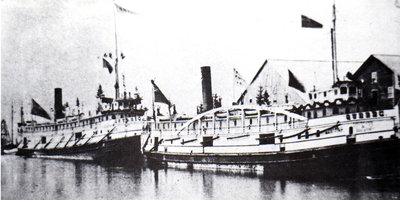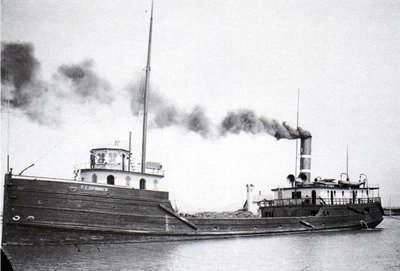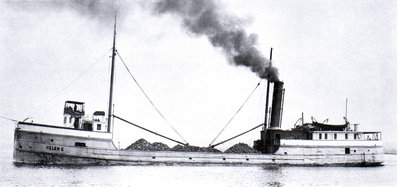Table of Contents
| Title Page | |
| Meetings | |
| The Editor's Notebook | |
| Marine News | |
| Ship of the Month No. 147 Quebec | |
| Rob Sharik | |
| Table of Illustrations |
Over many issues, commencing in January 1986, we have reviewed the history of the Beatty Line sidewheel passenger and freight steamer MANITOBA, and yet another follow-up piece on that vessel will soon appear. In the course of this protracted narrative, we have, on many occasions, mentioned another of the Beatty Line steamers, the propeller QUEBEC, for not only was she a running-mate of MANITOBA, but several of the incidents which we have related involved both steamers.
What better time, therefore, could there be to look into the details of the career of QUEBEC herself? We propose to detail herewith the highlights of her rather lengthy life, but whenever we mention an incident which already has been described in connection with MANITOBA, we will refrain from repeating all of the same material and will simply refer to those places in the earlier narrative where the appropriate details may be found.
The founder of the Beatty Line was William Beatty of Thorold, Ontario, in whose name some of the company's early vessels were first registered. The actual name of the firm was J. & H. Beatty and Company, and it was operated by William, along with his sons James H. and John D., and his nephew Henry. The line, which provided passenger and freight service from Windsor, Detroit and Sarnia (and sometimes Collingwood), via way ports to the Canadian and U. S. Lakehead ports, became known as the Northwest Transportation Company Ltd., Sarnia, in 1876, when the members of the Beatty family transferred their personal holdings in the shipping enterprise to the new corporation. It should be remembered that, in 1882, Henry Beatty left the family firm to become manager of lake shipping services for the Canadian Pacific Railway, and it was he who built the C. P. R. passenger and freight fleet into one of the major forces on the Canadian upper lakes. Henry's son, Edward (later to become Sir Edward Beatty), was destined to rise through the ranks in the C. P. R., and would serve for many years as the head of that international corporation.
QUEBEC (C. 71212) was a wooden-hulled combination passenger and freight propeller which was built in 1874 at Chatham, Ontario, by John Simpson and Duncan Chisholm, and she was launched on Wednesday, August 17th, of that year. Somewhat larger than MANITOBA, she was 186. 0 feet in length, 34.6 feet in the beam, and 13.4 feet in depth, these dimensions giving her tonnage of 1404 Gross. She was powered by a steeple compound engine, with cylinders of 34 and 34 inches, and a stroke of 34 inches, which was built for her by Burrows and Chapman at St. Catharines, Ontario. We have no details concerning her boilers and would be glad of any information in this respect which our readers might be able to provide.

QUEBEC and ONTARIO are seen at Kincardine in a photo courtesy of Ron Beaupre. The evergreen trees were decorations for the first trip of a anew season.
QUEBEC was a typical propeller of her day, with freight carried in the hold and on the main deck, which was accessible via large cargo ports in both sides of the enclosed main deck cabin. Most of the crew's quarters were also located on the main deck. The passenger accommodations were in the long deckhouse which was located on the upper (or promenade) deck. This cabin contained two rows of small staterooms, between which was a long open area, lighted from above by means of a clerestory. This area was normally used as lounge space, and it was there that, at meal times, the tables were set, for there was no space available for a separate dining saloon.
The pilothouse, a typically ornate octagonal structure surmounted by a high dome and decorative finial, was located far forward on the boat deck (the deckhouse roof), and the lifeboats were carried aft on this deck. A tall fidded mast, equipped to carry auxiliary sail, was set abaft the pilothouse. The steamer's single tall funnel was carried well aft, and a long flagstaff was stepped at the fantail. The hull was painted black to the main deck and the cabins were white. The stack was red with a black smokeband.
To give additional longitudinal strength to her wooden hull, QUEBEC was fitted with arch braces, which rose high above the deck on either side of the ship. A similar sort of longitudinal strength was provided for the many vessels which operated on the Western and Eastern Rivers of North America, by means of turnbuckled hog chains, which were strung atop angled poles. This system of bracing, however, was more suited to the peculiarities of river navigation, where adjustable bracing was a necessity and where hulls had to be far more limber while not being exposed to the rigours of violent seas. On the Great Lakes, operators usually favoured the more rigid bracing which was provided by arch frames, even though they obstructed space on the upper deck.
QUEBEC, along with the larger ONTARIO (and, of course, MANITOBA), operated from Windsor, Detroit and Sarnia to the ports at the head of Lake Superior, namely Silver Islet, Prince Arthur's Landing and Duluth. When weather conditions permitted, way stops were made at Goderich, Kincardine and Southampton, and also at Bruce Mines, St. Joseph's Island and Sault Ste. Marie. This service was operated in conjunction with the Grand Trunk, Great Western, and Canada Southern Railways, making close connections at Duluth with the Northern Pacific and also the St. Paul and Duluth Railroad for Winnipeg and points west. For details of the operations of the Beatty boats in the late 1870s, please refer to page 9 of the January 1986 issue.
Of course, as we have already mentioned in our discussions concerning MANITOBA, it would appear that the Northwest Transportation Company also had very close working arrangements with several other lake shipping interests, but nothing concrete can be said concerning the details of those arrangements. Such matters were seldom committed to paper in those days, and in the more than a century which has elapsed in the interim, any recollection of such inter-company "co-operation" has become lost from sight. It is today a matter of almost pure speculation, although once in a while the researcher comes upon printed items, such as newspaper advertisements, that strongly suggest the existence of such friendly back scratching amongst various operators.
Although MANITOBA was, after her first few years in Beatty service, sent off to work for other operators on various occasions, QUEBEC and ONTARIO provided a weekly service on their usual route and were very profitable, carrying a large number of passengers and a wide variety of general cargo. As an example, on one trip in June of 1880, QUEBEC brought down to Sarnia 3, 000 barrels of Minneapolis flour and a quantity of assorted package freight. When she departed on her return upbound trip, she was loaded with a large consignment of railroad iron and other merchandise. During July of the same year, she arrived downbound at Sarnia with 2, 000 barrels of flour and three carloads of axle grease.
QUEBEC was involved in a number of accidents during her career. The first of those of which we are aware occurred on Sunday, October 27, 1878, when she stranded, during a snow storm, on Magnetic Reef near Cockburn Island in northern Lake Huron. She grounded some four miles offshore and broke one of her arch braces in the process. She was carrying 150 tons of assorted freight at the time of the accident. The tugs E. M. PECK and MYSTIC were dispatched from Sault Ste. Marie to render assistance, however a press report of November 1878, stated that both tugs were wrecked after arriving at the scene of the stranding. One went on the beach, while the other was sunk "below her decks". The crews of the two tugs were rescued and were taken to St. Joseph's Island, while QUEBEC herself was released by the tugs MOCKING BIRD and PRINCE ALFRED, and arrived at Sarnia under tow on November 11, 1878. The two wrecked tugs were also salvaged and returned to service.
Then, on Thursday, September 4, 1879, with Capt. Anderson in command, QUEBEC found herself sheltering behind Chantry Island at Southampton, Ontario, along with MANITOBA. Various members of the crews of both ships used one of MANITOBA'S boats in an attempt to rescue the crew of the schooner MARY AND LUCY, which had struck the reef south of Chantry Island. Two of the would-be rescuers were lost in the ill-fated venture. Full details of the incident and the involvement of Elgin Belyea, first mate of the QUEBEC, can be found in pages 10 through 13 of our April 1986 issue.
Only a few years later, on Wednesday, November 14, 1883, QUEBEC and MANITOBA were involved in the famous incident wherein both were sheltering from late-season weather at Southampton and became victims of the Chantry Island shoals when a wind shift caught them on a lee shore. MANITOBA was blown ashore and QUEBEC was scuttled in shallow water to prevent her hull pounding on the bottom. When the weather moderated sufficiently, QUEBEC finally worked herself free (apparently with the assistance of the tug JOHN MARTIN). By the early morning of Saturday, November 17, QUEBEC was at the inside dock at Southampton, ready to sail on the resumption of her upbound trip when the weather improved. MANITOBA, of course, was not so lucky, and details of her protracted encounter with Chantry Island may be found in our January and March 1986 issues.
The next in the series of QUEBEC's adventures came on Wednesday, July 15th, 1885. At about 10:00 p. m., whilst downbound in the Wilson Channel (Lake George section) of the St. Mary's River, at the Devil's Gap in the North Passage near Bruce Mines, QUEBEC ran hard aground. Her running-mate, ONTARIO, happened to be in the vicinity, upbound, and removed the stricken steamer's cargo, which consisted of seven carloads of flour. On Thursday, July 16, QUEBEC slipped off the reef and sank stern-first in 120 feet of water. The wreck was finally raised on October 13, 1885, by Capt. S. A. Murphy, but QUEBEC never again operated for the Northwest Transportation Company.
The vessel was so severely damaged in the accident that she was of no further use to the Beatty Line. As well, with more efficient tonnage available, including the magnificent UNITED EMPIRE, which was launched in 1882, it was deemed impractical to expend the funds necessary to repair QUEBEC. Accordingly, on June 6, 1886, the steamer was sold to Thomas Adams of Detroit. He had her rebuilt for the freight trade by leaving her forward and after ends as they were but cutting her mid-section down to the main deck, leaving a high closed rail around the cargo area. The arch braces were also removed. A new pole mast was fitted forward and a thin and rather short pipe mast was stepped immediately forward of the after cabin. Adams put the ship back in service as (b) F. E. SPINNER (U. S. 120654), registered at Detroit. Word of the entry of the ship into the American register was carried in the Port Huron press on Saturday, September 25, 1886.
According to the U. S. List of Merchant Vessels, F. E. SPINNER was 186.0 feet in length, with a beam of 35.2 feet and depth of 12. 4 feet. Her tonnage was calculated as 1003.19 Gross and 777.57 Net. We do not believe that there was any change in her machinery at this time. Of interest is the fact that there are indications that the SPINNER received another rebuild in 1892, but we have no details as to the extent of that work, and it may have involved nothing more than hull renewal, a frequent necessity for wooden-hulled ships.

A turn-of-the-century photo shows F.E. SPINNER upbound above the Soo Locks with a coal cargo. The towline aft indicates that she was pulling a barge.
An article by David McMacken which appeared in "Inland Seas", Summer 1982 issue, outlined the career of Capt. Hawley Meeks Boyce, who in 1893 was master of the schooner JOHN B. MERRILL, owned at that time by the Connelly Brothers of Buffalo. On October 14, 1893, the MERRILL, loaded with coal, was upbound in tow of F. E. SPINNER, bound from Buffalo to Marquette. The steamer and her tow were beset by a heavy gale and attempted to seek the shelter of the St. Mary's River. Off Drummond Island, the sails were blown out of the MERRILL and the towline parted, and at 4:00 p. m., the schooner ran on a reef, where she broke up the next day. There is no record of the SPINNER receiving any damage in this incident.
F. E. SPINNER operated for Thomas Adams for more than a decade, but during the 1899 season she was sold to D. J. Ransom of Sault Ste. Marie, Michigan, He had her reclassified as a lumber carrier and her home port was changed to Marquette, Michigan. She may have been rebuilt again at this time, but we lave no way of verifying whether this was the case.
It was not long after the SPINNER entered service for Ransom that she once again got into trouble. On Monday, October 15, 1900, the ship was sunk as a result of a collision with the wooden-hulled steamer H. D. COFFINBERRY in the St. Mary's River near the Soo. Once more, however, she proved to be a salvageable proposition and she soon was raised and placed back in service in the lumber trade. She did, nevertheless, sustain considerable damage in the accident, and accordingly she was given new forward cabins, including a more "modern" square pilothouse, which sat on the forecastle in front of a small texas cabin. An open navigation bridge was located on the monkey's island.
The vessel changed hands again in 1902, when Capt. G. J. (John) Smith of Manistee Michigan, purchased her. He renamed her (c) HELEN C. in honour of his daughter, Helen Chase Smith, and reregistered her at Grand Haven, Michigan. Photographs of the day show that HELEN C. was given a new after cabin, with a steel boilerhouse. As well, she sported a new and more substantial main mast, and cargo booms had been fitted on both spars. Her new tonnage was 622 Gross and 460 Net. HELEN C. was to carry this updated appearance through to the end of her days.

Young photo of HELEN C., taken at Little Rapids Cut in 1916, caught her upbound with a cargo of coal.
Capt. Smith operated HELEN C. in the lumber and coal trades until 1914, when she was sold to William T. Hoey of Alpena, Michigan. He, in turn, resold her to William C. Brown of Plymouth, Michigan, who had her reregistered once more, this time at Detroit.
There is a report that HELEN C. was badly damaged in a stranding at Cutler, Ontario, on October 16, 1920. Apparently she was repairable (lumber carriers of her type were remarkably resilient, despite their advanced age), but she did not remain in service for very much longer. She foundered in Lake Huron off Alpena on Saturday, October 14th, 1922, and this time no attempt was made to salvage her remains.
Ed. Note: For their assistance in providing material for this feature, we extend our thanks to Ron Beaupre and to Rev. Peter J. Van der Linden.
Previous Next
Return to Home Port or Toronto Marine Historical Society's Scanner
Reproduced for the Web with the permission of the Toronto Marine Historical Society.